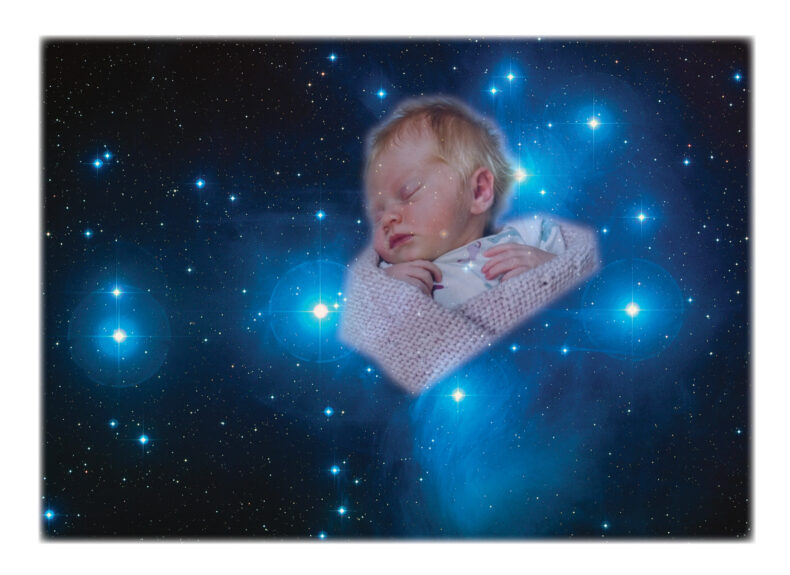
Last week, I crabbed over papers at a late-night kitchen table while my very pregnant step daughter stood near me with her hands clasped atop the globe of her belly. She’d been pacing for most of an hour, not wanting to sleep or sit down. She wanted her pelvis as open as she could make it.
Her body posture said, tell me something interesting.
“Have you heard of galactic archaeology?” I asked.
She pondered without moving her hands, as if leaning on the table of herself. “Galactic archaeology,” she repeated.
She had talked to everyone else in the house, teetering on her mother’s shoulder saying how afraid she was, this being her first time, and she’d chatted up her love on the couch about plans, schedules, go-bag ready by the door. I was working on cosmology, the logical next step for her evening.
I read to her the first line of the paper before me, entitled: “Chemical Inhomogeneities in the Pleiades: Signatures of Rocky-forming Material in Stellar Atmospheres” by Lorenzo et. al., 2018, in The Astrophysical Journal. The line was, “The aim of Galactic archaeology is to recover the history of our Galaxy through the information encoded in stars.”
This caused the mother-to-be to stand with greater stillness as she thought about what this meant. “This is an actual science?” she asked.
“Apparently,” I said.
Galactic archaeologist is something I’d enjoy flashing on a name tag, the Indiana Jones of astrophysicists. We both laughed at science being so inquisitive that it looks at our galaxy like a fossil, studying its foramina and sockets, putting back together the ancient beast of an ancestral Milky Way.
I read the next line to her: “An unprobed assumption of this field is that the chemical composition of a star is an immutable marker of the gas from which it formed.”
“They can tell where certain stars were born,” she mused.
I said, “They can trace them back to their sources with other stars and reconstruct what the galaxy used to be like. Like an excavation.”
She said, “Like one of those peg boards in a detective’s office with strings tied between them.”
As we spoke, the tiny girl with baby-corn toes curled up unseen inside of my step daughter listened. I don’t know what she was hearing, the strange muffle of our voices, but she understood the tones we used and the quiet of the house late at night. Maybe she knew we were talking about stars and where they come from, an exchange about birth. She might have wanted to interject or ask a question. Who knows what happens before the tidal wave of labor and delivery? There has to be a bit of forgetting.
That night, I’d been writing about the formation of the Pleiades, an open star cluster about 400 light years away consisting of at least a thousand newborn stars. This bright little asterism off the bow of Orion is commonly called the Seven Sisters for its tight-knit six or seven brightest stars. In Cherokee, Iroquois, and early Greek astronomy they are known as sisters, and to the Tuareg Berbers of the northern Sahara they are Cat ahăḍ, “daughters of the night.” There is something feminine about them, gathered tightly and as bright as crushed diamonds.
Each star in the Pleiades is of the same young age, a hundred million years old, and they all have the same bright-white chemistry that gives the Seven Sisters their phosphorescence. This means they were all born together, came from the same source, and gravity is enough to keep them loosely together before they mix into the swirl of our galaxy. We are seeing them in this last moment where they are all together, they all know each other like siblings. What happens next will be a diaspora into the Orion Arm of the Milky Way Galaxy where they will mix with blue giants and brown dwarves. For these brief millions of years, we see them fresh out of the gate.
She winced and her hands cupped her belly. I stayed quiet for a moment and she opened her eyes . “Come on, baby,” she said.
Image: composite of Pleiades (NASA, ESA, AURA/Caltech, Palomar Observatory) and a photo of my newborn grand-baby Viviana, composed by my wife, Daiva Chesonis.
I read somewhere recently (and wish I had saved the source) that us, being composed & created from star dust, each have signatures that could tell us which star we came from…. Our cosmama!
That’s a lovely thought, Andrea, and I (astronomy writer here) have never heard anyone say it before. It’s almost certainly not the case: earth and the rest of the planets formed out of the same stuff that formed the sun, so all of us humans are made alike. Maybe the source you read was confusing another lovely thought: that our sun (and earth and us) has elements that were made in previous generations of stars. Here’s a nice explanation: https://www.nhm.ac.uk/discover/are-we-really-made-of-stardust.html. And didn’t Craig write a lovely post? yes, he did.
I do know that our teeth hold an isotopic record of where we were born, and where we spent most of our lives. One way or another, we’re a bunch of dust!
What a gorgeous essay, Craig! And congratulations to the new parents and their parents.
It’s reassuring that we come from stardust and that humans can’t claim to have invented our species
A bunch of dust all animated and liquified and creatively rendered and mobile, wild and weird in 7 plus billion beautiful ways … Thank you Craig for once again sharing your curiosity and love! Congratulations!